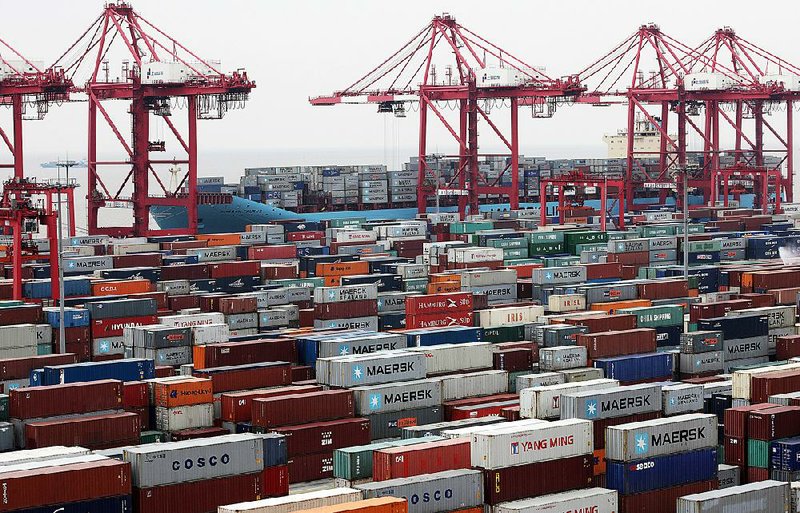LITTLE ROCK — China surpassed the U.S. last year to become the world’s biggest trading nation as measured by the sum of exports and imports of goods, official figures from both countries show.
U.S. exports and imports of goods last year totaled $3.82 trillion, the U.S. Commerce Department said last week. China’s customs administration reported last month that the country’s trade in goods in 2012 amounted to $3.87 trillion.
China’s growing influence in global commerce threatens to disrupt regional trading blocs as it becomes the most important commercial partner for some countries. Germany may export twice as much to China by the end of the decade as it does to France, estimated Goldman Sachs Group Inc.’s Jim O’Neill.
“For so many countries around the world, China is becoming rapidly the most important bilateral trade partner,” said O’Neill, chairman of Goldman Sachs’ asset management division and the economist who combined Brazil, Russia, India and China into his BRIC investment strategy. “At this kind of pace, by the end of the decade, many European countries will be doing more individual trade with China than with bilateral partners in Europe.”
When taking into account services, U.S. total trade amounted to $4.93 trillion in 2012, according to the U.S. Bureau of Economic Analysis. The U.S. recorded a surplus in services of $195.3 billion last year and a goods deficit of more than $700 billion, according to Bureau of Economic Analysis figures released Friday. China’s 2012 trade surplus, measured in goods, totaled $231.1 billion.
The U.S. economy is also double the size of China’s, according to the World Bank. In 2011, the U.S. gross domestic product reached $15 trillion while China’s totaled $7.3 trillion. China’s National Bureau of Statistics reported Jan. 18 that the country’s nominal gross domestic product in 2012 totaled $8.3 trillion.
“It is remarkable that an economy that is only a fraction of the size of the U.S. economy has a larger trading volume,” said Nicholas Lardy, a senior fellow at the Peterson Institute for International Economics in Washington. The increase isn’t all the result of an undervalued yuan fueling an export boom, as Chinese imports have grown more rapidly than exports since 2007, he said.
The U.S. emerged as the pre-eminent trading power after World War II as it spearheaded the creation of the global trade and financial architecture. Protectionist policies in the 1930s had exacerbated the global economic depression. At the same time the U.K., the leading trading nation of the 19th century, began to dismantle its colonial empire.
China began to focus on trade and foreign investment to enhance its economy after decades of isolation under Chairman Mao Zedong, who died in 1976. Economic growth averaged 9.9 percent a year from 1978 through 2012.
China became the world’s biggest exporter in 2009, while the U.S. remains the biggest importer, taking in $2.28 trillion in goods last year compared with China’s $1.82 trillion of imports. HSBC Holdings Plc forecast last year that China would overtake the U.S. as the top trading nation by 2016.
China was last considered the leading economy during the height of the Qing dynasty. The difference is that in the 18th century, the Qing Empire - unlike rising Britain - didn’t focus on trade. The Emperor Qianlong told King George III in a 1793 letter that “we possess all things. I set no value on objects strange or ingenious, and I have no use for your country’s manufactures.”
While China is the biggest energy user, has the world’s biggest new-car market and the largest foreign currency reserves, a significant portion of China’s trade involves the importing of raw materials and parts to be assembled into finished products and re-exported, an activity that provides “only modest value added,” said Eswar Prasad, a former International Monetary Fund official who is now a professor at Cornell University in Ithaca, N.Y.
Last month, China’s trade expanded more than estimated, with exports rising 25 percent from a year earlier and imports increasing 28.8 percent, government data released Friday showed. China’s trade figures in January and February are distorted by the week-long Lunar New Year holiday that fell in January of last year and started Saturday this year.
Economists from banks including UBS AG and Australia & New Zealand Banking Group Ltd. recently expressed skepticism about China’s export data after the customs administration reported an unexpected 14.1 percent export gain in December. The General Administration of Customs defended the data last month, saying all statistics are based on actual customs declarations, and the Ministry of Commerce said the jump was caused by exporters who hurried shipments before a waiver of inspection fees expired at the end of the month.
The U.S.’ bilateral trade deficit with China, which peaked in 2012, could remain a flashpoint of tension between the two countries, Prasad said.
“This trade imbalance is not representative of the amount of goods actually produced in China and exported to the U.S., but this perspective tends to get lost amidst the heated political rhetoric in the U.S.,” said Prasad.
According to O’Neill, the trade figures highlight the need to draw China further into the global financial and trading architecture that the U.S. helped create.
“One way or another, we have to get China more involved in the global organizations of today and the future despite some of their own reluctance,” O’Neill said. “To not have China more symbolically and more importantly actually central to all these things is just increasingly silly.” Information for this article was contributed by Joshua Gallu of Bloomberg News.
Front Section, Pages 1 on 02/12/2013
